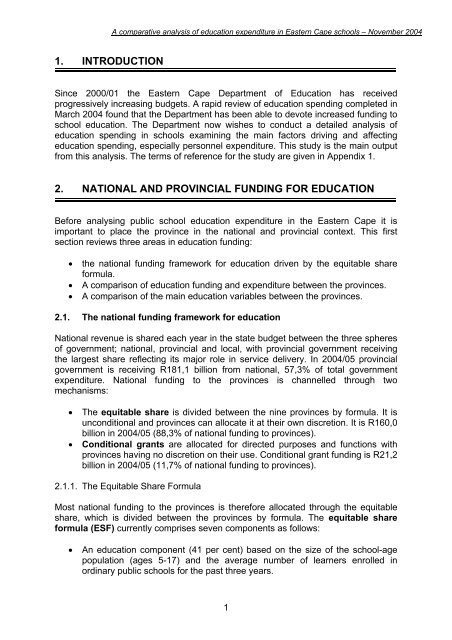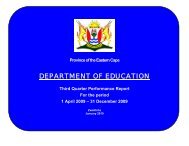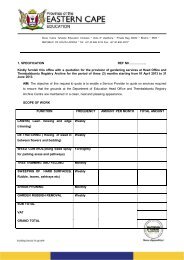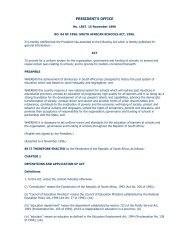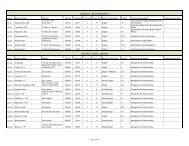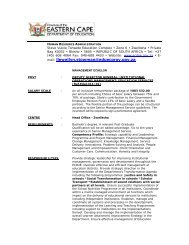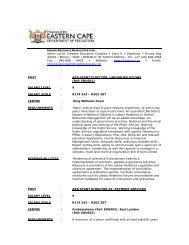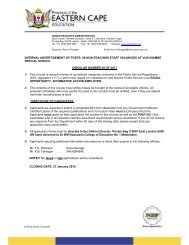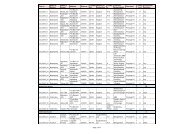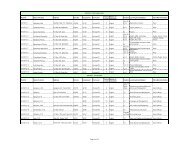School Community Integration Pilot Project - Department of Education
School Community Integration Pilot Project - Department of Education
School Community Integration Pilot Project - Department of Education
You also want an ePaper? Increase the reach of your titles
YUMPU automatically turns print PDFs into web optimized ePapers that Google loves.
A comparative analysis <strong>of</strong> education expenditure in Eastern Cape schools – November 2004<br />
1. INTRODUCTION<br />
Since 2000/01 the Eastern Cape <strong>Department</strong> <strong>of</strong> <strong>Education</strong> has received<br />
progressively increasing budgets. A rapid review <strong>of</strong> education spending completed in<br />
March 2004 found that the <strong>Department</strong> has been able to devote increased funding to<br />
school education. The <strong>Department</strong> now wishes to conduct a detailed analysis <strong>of</strong><br />
education spending in schools examining the main factors driving and affecting<br />
education spending, especially personnel expenditure. This study is the main output<br />
from this analysis. The terms <strong>of</strong> reference for the study are given in Appendix 1.<br />
2. NATIONAL AND PROVINCIAL FUNDING FOR EDUCATION<br />
Before analysing public school education expenditure in the Eastern Cape it is<br />
important to place the province in the national and provincial context. This first<br />
section reviews three areas in education funding:<br />
• the national funding framework for education driven by the equitable share<br />
formula.<br />
• A comparison <strong>of</strong> education funding and expenditure between the provinces.<br />
• A comparison <strong>of</strong> the main education variables between the provinces.<br />
2.1. The national funding framework for education<br />
National revenue is shared each year in the state budget between the three spheres<br />
<strong>of</strong> government; national, provincial and local, with provincial government receiving<br />
the largest share reflecting its major role in service delivery. In 2004/05 provincial<br />
government is receiving R181,1 billion from national, 57,3% <strong>of</strong> total government<br />
expenditure. National funding to the provinces is channelled through two<br />
mechanisms:<br />
• The equitable share is divided between the nine provinces by formula. It is<br />
unconditional and provinces can allocate it at their own discretion. It is R160,0<br />
billion in 2004/05 (88,3% <strong>of</strong> national funding to provinces).<br />
• Conditional grants are allocated for directed purposes and functions with<br />
provinces having no discretion on their use. Conditional grant funding is R21,2<br />
billion in 2004/05 (11,7% <strong>of</strong> national funding to provinces).<br />
2.1.1. The Equitable Share Formula<br />
Most national funding to the provinces is therefore allocated through the equitable<br />
share, which is divided between the provinces by formula. The equitable share<br />
formula (ESF) currently comprises seven components as follows:<br />
• An education component (41 per cent) based on the size <strong>of</strong> the school-age<br />
population (ages 5-17) and the average number <strong>of</strong> learners enrolled in<br />
ordinary public schools for the past three years.<br />
1


